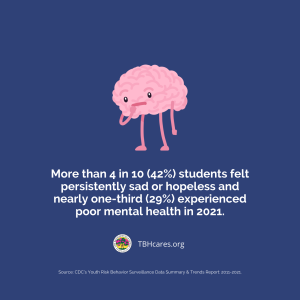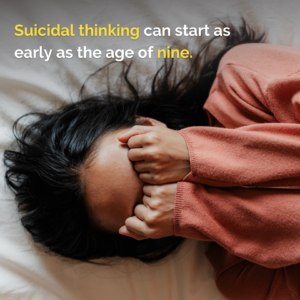Thanks to 24/7 access to global news and information, public awareness of human trafficking has grown over the past few years. Even so, it is a crime that lives in the shadows of too many communities in America and around the world. TBH wants to do its part to help educate families about this issue and the role we can all play to prevent and report this abuse of the most vulnerable among us.
What is Human Trafficking?
The Department of Homeland Security defines human trafficking as “the use of force, fraud, or coercion to obtain some type of labor or commercial sex act”. Although illegal in the US, it is believed millions of people are trafficked every year, but it is a significantly underreported crime.

Types of Human Trafficking
A common misconception is that human trafficking is synonymous with sex trafficking. Although sex trafficking is all too prevalent, human trafficking also includes forced labor. Below you’ll find some of the most common types of trafficking:
- Sex Trafficking: individuals are coerced into performing sexual acts including prostitution, participating in pornographic content, stripping, working as an escort, and sex tourism. Any minor who performs commercial sexual acts is considered a victim of sex trafficking, because they cannot legally consent to them.
- Forced Labor: victims provide labor or services through coercion and threats. Some common types include debt bondage and child labor. This type of human trafficking is less common in the US than sex trafficking, but too many unaccompanied minors, such as those entering the US alone, are at risk of being coerced by “sponsors” into “working off their debt” with long hours in tiring and dangerous jobs.
- Domestic Servitude: performing labor or services within an employer’s household. Domestic work becomes trafficking when the employer coerces or threatens the worker until he or she believes the only choice is to stay. Immigrants are often more vulnerable to this type of trafficking.
What Groups Are Most at Risk?
Although victims can be of any age, race, socioeconomic background, and gender, traffickers tend to prey on victims they perceive as vulnerable and easily controlled, so they’ll often go after people who are:
- Experiencing economic hardship
- Seeking opportunities to build a better life
- Struggling with addiction
- Suffering from mental health issues
- Emotionally and/or physically estranged or separated from family and friends
More specifically, human traffickers will go after marginalized groups like:
- Homeless youth
- Children and teens who have been in the foster care system
- People that do not have a lawful immigration status
- People of color
- Individuals within the LGBTQ+ community
Common Tactics Used to Lure Victims
Traffickers employ various tactics to identify and entrap their victims. According to Covenant House Toronto, 25% of their cases reported they were recruited by “friends or peers” who were also victims, and 33% reported they were lured by someone who was a romantic partner.
While traffickers do use the violent, forceful approach of kidnapping victims and forcing them into servitude, the most common tactic is the “soft sell”, a more insidious method, where the perpetrator turns on the victim after taking time to form bonds of trust. The trafficker identifies and contacts a vulnerable individual, promising whatever they think will appeal most, such as love, jobs, money, and security. They earn their victim’s trust, then force them into the desired form of trafficking.
What are Some Warning Signs?
To fight against human trafficking in all its forms, start by learning how to identify “red flags” that may need to be reported to the authorities. If you know someone living under these conditions, according to the Department of Justice, these may be warning signs that this person might be a victim of trafficking:
- They live with their employer in poor conditions
- They live with multiple people in a small, cramped place
- They have few or no identity documents
- They appear unable to speak on their own
- They are underpaid
- They exhibit submissive or fearful behavior
- Their partner may be significantly older and displays controlling and isolating behavior
- The person appears to be school age, but does not attend school
It’s important that you share these warning signs with people around you, including your teenage children.

Since so many perpetrators masquerade as people pretending to be romantic partners, discuss this tactic with your teen so they know when to be wary. Encourage them to tell you if they are talking to someone (whether in person or online), but something feels off. By making your teen and their friends aware of the risks, you can help to keep them safe.
How to Support Victims
If you think someone you know is a victim of human trafficking, call the national hotline at 888-373-7888 or text 233733 to report a case at the National Human Trafficking Hotline. You can also report it to local law enforcement by calling 911.
Another way to support victims is to help them find resources. Here you’ll find a list of helpful services ranging from mental health care to employment aid.
If you don’t personally know any victims, but still want to support them in some way, you can always raise awareness about this issue on social media. Whether it’s reposting statistics, telling someone’s story, or sharing information provided by local organizations, raising awareness helps to make everyone in the community more vigilant and willing to report possible situations in the future.
Be aware that not all online sources are legitimate, nor is all content on social media accurate. In fact, lately many people have been sharing misinformation on this issue. Although most of the accounts posting about “possible” human trafficking tactics don’t mean harm, they misrepresent what it looks like.
The insidious approach often used by human traffickers can make their crime difficult to notice and identify. Although it’s always good to keep an eye out for anything that looks or feels off, traffickers don’t often kidnap random people. Instead, they go for people who are particularly vulnerable.
Organizations that Raise Awareness about Human Trafficking
If you want to get involved in the fight against human trafficking, we encourage you to check out organizations focused on this issue. It’s always good to seek out non-profits near you, but in the meantime, we’ll leave you with three of the biggest and most trusted organizations you might want to support:
- International Justice Mission: This organization works to end all types of modern-day slavery, including the labor and sex trafficking of individuals regardless of age.
- Polaris Project: One of the biggest organizations, Polaris combats all forms of trafficking of individuals of any age. In addition to their work, they also dedicate their time to gathering data from the National Human Trafficking Hotline in order to aid more people.
- Love146: This international non-profit focuses on ending child trafficking. Love146 offers both prevention programs and services for survivors in the US and in the Philippines.
- United Abolitionists: this Florida organization focuses on acting as first responders for human trafficking cases, providing victims with care, and raising awareness.
Need More Help?
If you or anyone you know is struggling with mental health, consider contacting professional help. Here at The Bougainvilla House, we’ll provide you with a safe space and compassionate care as you learn to cope, heal, and live a healthier life.
Call now to find support for you and your family: (954) 764-7337.







 Identify and reduce triggers: This is an important step in helping your teen manage their strong emotions. Encourage them to look for patterns in their environment and situations when they experience intense feelings. Sometimes, these emotions can stem from deep insecurities or past trauma, making it initially challenging to pinpoint their cause. However, having awareness of triggers is empowering, as it allows your teen to avoid them when possible and feel more in control when they cannot be avoided. Prompt your teens to reflect on what is happening around them and why it reminds them of something painful. By understanding and acknowledging these triggers, your teen can take proactive steps to minimize their impact on their emotional well-being.
Identify and reduce triggers: This is an important step in helping your teen manage their strong emotions. Encourage them to look for patterns in their environment and situations when they experience intense feelings. Sometimes, these emotions can stem from deep insecurities or past trauma, making it initially challenging to pinpoint their cause. However, having awareness of triggers is empowering, as it allows your teen to avoid them when possible and feel more in control when they cannot be avoided. Prompt your teens to reflect on what is happening around them and why it reminds them of something painful. By understanding and acknowledging these triggers, your teen can take proactive steps to minimize their impact on their emotional well-being.
















